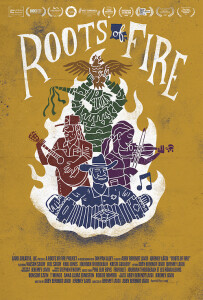 Anyone who enjoys Francophone Louisiana roots music and music documentaries in general will love Roots of Fire. The film focuses in particular on the young musicians who are bringing Cajun music into the 21st century, honoring their past and their forbears while moving the music forward and making it their own.
Anyone who enjoys Francophone Louisiana roots music and music documentaries in general will love Roots of Fire. The film focuses in particular on the young musicians who are bringing Cajun music into the 21st century, honoring their past and their forbears while moving the music forward and making it their own.
Prominently featured in the film are the words and music of Kristi Guillory, folklorist and accordion player with the all-woman Cajun band Bonsoir, Catin; fiddler and Cajun culture warrior Jourdan Thibodeaux of the band Les Rôdailleurs; and Kelli Jones, fiddler, singer, and songwriter with Feufollet. But most especially it features Joel Savoy and his brother Wilson Savoy, sons of Cajun music and culture revivalists Marc and Ann Savoy. Wilson and Joel played with their parents in the Savoy Family Band and also have their own bands (notably Joel’s Red Stick Ramblers) and are either members of or regularly sit in with numerous other ensembles. All of them are as articulate as they are enthusiastic about their music and culture.
Filmmakers Abby Berendt Lavoi and Jeremey Lavoi began the Roots of Fire project to capture and share stories from the world of South Louisiana roots music in a style that would appeal to audiences outside of Louisiana — hopefully growing the fan bases of both Cajun and Zydeco music in the process.
“It is not our intention to make an authoritative work on Cajun music, its vibrant history, or even its contemporary diaspora,” say the Lavois. “We wanted to make something that was authentic to our sensibilities, something entertaining, and something that feels like a window into this colorful artistic community.” They’ve succeeded and then some. It’s one of the best recent music documentaries I’ve seen.
The film necessarily draws extensively on the words of its participants, but it hardly ever resorts to the boring talking-heads format. The musicians are captured as they go about their lives and in the process of creating their art, and all of them are very articulate.
“Cajun music is the product of many different cultures that found themselves in southwestern Louisiana,” Joel Savoy says early on. Jourdan Thibodeaux, with his jutting jawline and big-brimmed brown cowboy hat and his deep Cajun French accent, says several times, “You’re either living your culture or you’re killing your culture.”
The film is presented in three acts, more or less. The first introduces us to the main young musicians we’re following, revolving around a potluck dinner at one of their homes where Joel Savoy has gathered many of the musicians who were in the bands that were nominated for Grammys in the Regional Roots category in 2017, including Barry Jean Ancelet & Sam Broussard, Roddie Romero & The Hub City All-Stars, and a bunch of players who were involved in the soundtrack to a previous documentary about the music’s history, I Wanna Sing Right: Rediscovering Lomax in the Evangeline Country.
The next act focuses on the annual Faquetaique Courir de Mardi Gras, which Joel Savoy founded in 2006 as an alternative to existing Cajun country Mardi Gras events, with this one focusing more on music and community participation.
Always in this film the music is front and center, with these young musicians performing on stages at big events like Festivals Acadiens et Créoles in Lafayette, in clubs and little community dance halls, and in their own kitchens, livingrooms and front porches. (I was excited to see Feufollet perform “Femm l’a Dit,” one of my favorite tracks off their 2008 disc Cow Island Hop.)
“We also wanted to make a film that was very music-forward and devoted as much running time as we could justify to hearing—and feeling—the actual music,” the Lavois say. “At the end of the day, experiencing this music live is the best way to consume it. From day one of this project, it has been our goal to capture that experience as faithfully as possible.”
All of the featured musicians are intimatelly acquainted with the history of Cajun music, and in fact most are descended from its first-wave and second-wave pioneers. The filmmakers have captured the vibrant essence of the scene these musicians have created and are struggling to maintain, even as its main audience is rapidly reaching the age when they can no longer pack the dance floors. They’re doing that by being faithful to their own muses, making the music their own way, not in some way perceived by fans and outsiders as “authentic.”
“It’s changing and it’s growing and it’s going to be different,” Joel Savoy says. “It’s not going to make everybody happy. It’s never gonna look exactly like it did 100 years ago but it’s going to keep the same core values and I think that’s what’s important and I feel confident about the future of Cajun music because of it.”
Or as Kelli Jones says with a twinkle, “It’s like, the same folk music my parents listened to … but cooler.”
Now streaming on Apple TV. Highly recommended.
Follow Roots of Fire on the official website | Facebook | Twitter | YouTube | Instagram | Vimeo
(Roots of Fire/Lavoi Creative, 2022)
